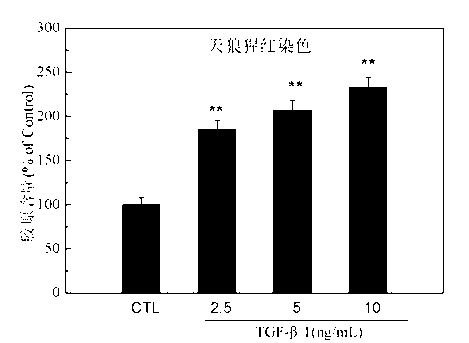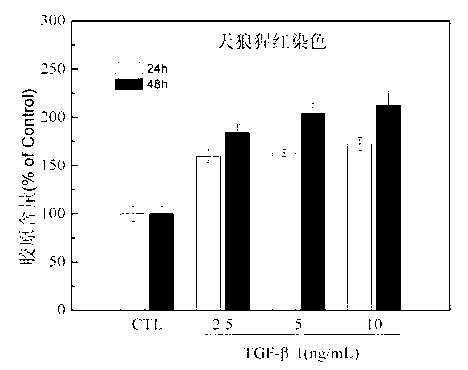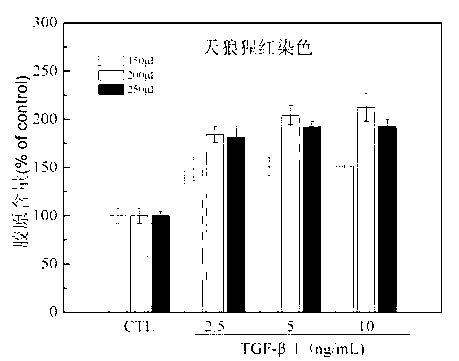Picric acid-sirius red staining method and application thereof in screening anti-hepatic fibrosis compound
A technology of Sirius scarlet and picric acid, applied in the biological field, can solve the problems of unstable experimental results, difficult to achieve high-throughput screening of anti-hepatic fibrosis compounds, and long cycle.
- Summary
- Abstract
- Description
- Claims
- Application Information
AI Technical Summary
Problems solved by technology
Method used
Image
Examples
Embodiment 1
[0017] Example 1 Model establishment.
[0018] (1) Select CFSC-8B cells in the logarithmic growth phase, and adjust the concentration of the cell suspension to 8×10 with complete medium 4 Cells / mL, inoculated in 96-well plate, 100 μL per well, when the cells grew to 70-80%, cultured in complete medium containing 0.5% FBS for 24 hours to starve the cells to achieve synchronization.
[0019] (2) The experiment is divided into the following groups:
[0020] CFSC-8B cell conventional culture (control) group; CFSC-8BTGF-β1 modeling dose (0, 2.5, 5, 10ng / mL) group; time group (24h and 48h); different staining solution volume (150, 200, 250μL )Group.
[0021] (3) Piric acid Sirius scarlet staining. After culturing for 24h and 48h respectively according to step (2), rinse the cells with PBS three times, fix with Bouin's fluid at room temperature for 1h, discard the fixation solution, wash the culture plate with PBS three times (until there is no yellow color of the fixation soluti...
Embodiment 2
[0024] Example 2 Screening of anti-hepatic fibrosis compounds
[0025] (1) MTT was used to detect the survival rate of different bacterial powder extracts on cells. Select CFSC-8B cells in the logarithmic growth phase, and adjust the concentration of the cell suspension to 3×10 with complete medium 4 1 / mL, inoculated in 96-well plate, 100 μL per well, continued to culture for 24 hours, added Antrodia camphorata, Ganoderma lucidum, Cordyceps cephalosporin, Cordyceps mortierella, Gastrodia elata and Hericium erinaceus powder with different polarity extracts n-hexane, chloroform, Ethyl acetate, methanol (200μg / ml, 100, 50, 25, 12.5, 6.25, 3.125μg / mL), continue to culture for 24h and 48h, and add 10μL of MTT (5mg / ml) 4h in advance, continue to incubate for 4h, suck Discard the culture medium, add 150 μL of DMSO to each well, shake for 10 min, and measure the OD value at 570 nm with a microplate reader. The cell survival rate was calculated according to the following formula: the...
PUM
 Login to View More
Login to View More Abstract
Description
Claims
Application Information
 Login to View More
Login to View More - R&D
- Intellectual Property
- Life Sciences
- Materials
- Tech Scout
- Unparalleled Data Quality
- Higher Quality Content
- 60% Fewer Hallucinations
Browse by: Latest US Patents, China's latest patents, Technical Efficacy Thesaurus, Application Domain, Technology Topic, Popular Technical Reports.
© 2025 PatSnap. All rights reserved.Legal|Privacy policy|Modern Slavery Act Transparency Statement|Sitemap|About US| Contact US: help@patsnap.com



